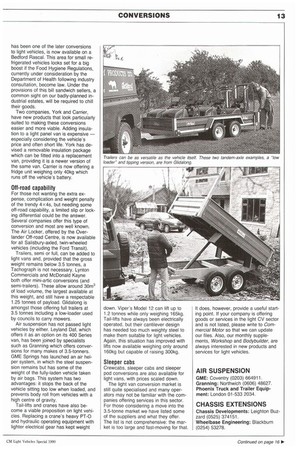What's yours called?
Page 140

Page 141

If you've noticed an error in this article please click here to report it so we can fix it.
Light vans under 3.5 tonnes are traditionally low-priced and consequently rather basic. On the other hand, operators buy them with any number of jobs in mind, so a new breed of body conversion specialists have cropped up to meet their needs.
The word van can mean different things to different people: to an Eastern European it means an estate car with the rear windows and seats removed: to an operator in the UK it can be a mobile workshop packed with equipment.
The vehicle market under the 3.5tonne Tachograph and 0-Licence limit is very price-sensitive, so most vans are fairly basic. Understandably, the manufacturers need volume sales if they are to recoup their investment in such an extremely tight market.
To make best use of a small van's advantages over an HGV in our congested high streets, however, requires more than a tin box on wheels. Converting the basic to the usable can take many forms depending on its intended use. But the numbers of each particular type of conversion (save dropsides and panel vans) are too small to interest the vehicle manufacturers.
To fill this gap between operators' needs and manufacturers' volume production requirements there has grown an industry of converters and bolt-on 'goodie' makers. So diverse has the industry become that nearly everything that could be done to an HGV can now be done to a light van, which may be a comfort to those who fear the lowering of the weight limit for an HGV licence from 7.5 to 3.5 tonnes.
Weight-sensitive operations such as refrigerated transport used to only be viable on the larger HGVs and, while it has been one of the later conversions to light vehicles, is now available on a Bedford Rascal. This area for small refrigerated vehicles looks set for a big boost if the Food Hygiene Regulations, currently under consideration by the Department of Health following industry consultation, become law. Under the provisions of this bill sandwich sellers, a common sight on our badly-planned industrial estates, will be required to chill their goods.
Two companies, York and Carrier, have new products that look particularly suited to making these conversions easier and more viable. Adding insulation to a light panel van is expensive — especially considering the vehicle's price and often short life. York has devised a removable insulation package which can be fitted into a replacement van, providing it is a newer version of the same van. Carrier is now offering a fridge unit weighing only 40kg which runs off the vehicle's battery.
Off-road capability For those not wanting the extra expense, complication and weight penalty of the trendy 4 x4s, but needing some off-road capability, a limited slip or locking differential could be the answer. Several companies offer this type of conversion and most are well known. The Air Locker, offered by the Overlander Off-road Centre, is now available for all Salisbury-axled, twin-wheeled vehicles (including the Ford Transit).
Trailers, semi or full, can be added to light vans and, provided that the gross weight remains below 3.5 tonnes, a Tachograph is not necessary. Lynton Commercials and McDonald Kayne both offer mini-artic conversions (and semi-trailers). These allow around 30m3 of load volume, the largest available at this weight, and still have a respectable 1.25 tonnes of payload. Glidalong is amongst those offering full trailers at 3.5 tonnes including a low-loader used by councils to carry mowers.
Air suspension has not passed light vehicles by either. Leyland Daf, which offers it as an option on its 400 Series van, has been joined by specialists such as Granning which offers conversions for many makes of 3,5-tonners. GME Springs has launched an air helper system, in which the steel suspension remains but has some of the weight of the fully-laden vehicle taken by air bags. This system has two advantages: it stops the back of the vehicle sitting too low when loaded, and prevents body roll from vehicles with a high centre of gravity.
Tail-lifts and cranes have also become a viable proposition on light vehicles. Replacing a crane's heavy PT-0 and hydraulic operating equipment with lighter electrical gear has kept weight down. Viper's Model 12 can lift up to 1.2 tonnes while only weighing 165kg. Tail-lifts have always been electrically operated, but their cantilever design has needed too much weighty steel to make them suitable for light vehicles. Again, this situation has improved with lifts now available weighing only around 160kg but capable of raising 300kg.
Sleeper cabs Crewcabs, sleeper cabs and sleeper pod conversions are also available for light vans, with prices scaled down.
The light van conversion market is still quite specialised and many operators may not be familiar with the companies offering services in this sector. For those considering a move into the 3.5-tonne market we have listed some of the suppliers and what they offer. The list is not comprehensive: the market is too large and fast-moving for that.
It does, however, provide a useful starting point. If your company is offering goods or services in the light CV sector and is not listed, please write to Commercial Motor so that we can update our files. Also, our monthly supplements, Workshop and Bodybuilder, are always interested in new products and services for light vehicles.




































































































































































